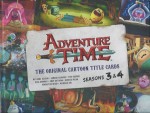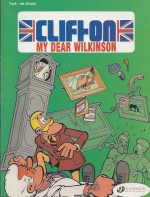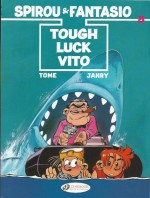
By Adam Murphy (David Fickling Books)
ISBN: 978-1-910200-49-0
The educational power of comic strips has been long understood and acknowledged: if you can make the material memorably enjoyable, there is nothing that can’t be better taught with pictures. The obverse is also true: comics can make any topic or subject come alive… or at least – as here – outrageously undead…
The conceit in Adam Murphy’s wonderful Corpse Talk is that famous personages from the past are exhumed for a chatty, cheeky This Was Your Life talk-show interview that, in Reithian terms, simultaneously “elucidates, educates and entertainsâ€. It also often grosses one out, which is no bad thing for either a kids’ comic or a learning experience…
Another splendid album release culled from the annals of The Phoenix (courtesy of those fine saviours of weekly comics at David Fickling Books) opens with some ‘Introductory Remarks’ from your scribbling, cartooning host macabre Adam Murphy before the creepy contents section ‘In the Guest Graveyard This Season’ runs down the disinterred interviewees on show this time…
Before the inspirational post-mortem autobiographies commence there’s also a splendidly informative archaeological burial-map entitled ‘Digging up the Bodies’ providing an effectively contextual visual timeline for the likes of saucy ‘Queen Victoria’ and foolish ‘Guy Fawkes’ to discuss their successes and failures before we learn the gory truth about ‘William the Conqueror’, which last is supplemented by a grotesque, ghastly glimpse of what happened at his shocking state funeral in double-page spread ‘William the Honk-eror’…
Heading further back in time – and perhaps into fiction rather than fact – comes an intimate investigation into the truth behind Greek poet ‘Homer’ and far more confirmable confabs with engineering phenomenon ‘Isambard Kingdom Brunel’ and infamous Russian ruler ‘Catherine the Great’ which comes with a fact feature on the plague of impostors who tried to unseat her in ‘Tsars in their Eyes!’
Game-changing artistic iconoclast ‘Henri Matisse’ shares the spotlight with true life inspiration for Robinson Crusoe ‘Alexander Selkirk’, after which a thorough expose of ‘Elizabeth I’ is rounded off with a ‘A Killer Look!’ at the vast array of clothing gimmicks, fashion accessories and make-up marvels she employed to stay at the height of her power, whilst at the other end of the spectrum fun-crushing ‘Oliver Cromwell’ stands proudly on his reputation for dour and dismal progress…
I for one will be forever grateful for learning for the first time ever (!) about ‘Maria Sibylla Merian’, a grossly misused scientific pioneer who founded the principles of entomology before being written out of history by male historians and scientists. Let this light-hearted examination be just the first of her many mentions please…
No suspicious suppression for the next star spectre as ‘William Shakespeare’ tells it like it was, accompanied by a short summary of his acting career in ‘Ghost Writer!’ after which the page-count temporarily doubles to encompass the American exploits of ‘Leif Erikson (and Family)’ – papa Erik the Red, mother Thjodhild, and siblings Thorvald, Thorsten & Freydis – before dropping back to normal for party favourite ‘Charles II’ who cockily details his fall, exile, return and rise to adored majesty.
The truth about ‘Pocahontas’ is followed by more telling Native American facts in ‘Sad Ending, Continued…’ whilst the glorious career of ‘Stan Laurel and Oliver Hardy’ serves to cheer us all up and the personalised revelations of ‘Sir Francis Drake’ clarify the very, very slim difference between privateer and pirate.
The astounding achievements of polymath and scientific everyman ‘Sir Christopher Wren’ is followed by a bold and brilliant depiction of ‘The Great Fire of London’ which allowed him to cement his place in history whilst the stellar career and cruelly embarrassing end of female aviator ‘Amy Johnson’ precedes a chilling conclusion when ‘Vlad the Impaler’ recounts his favourite things and how much pain they caused everyone else…
This second star-stuffed catalogue of comedy cadaver chronicles then concludes with a little game-segment as ‘The End of the Season’ sees all the guests going walkabout, requiring a ‘Rotting Remains Roll-Call’ for the reader to locate and return them to their places of rest
Smart, irreverent, funny and splendidly factual throughout, The Phoenix Presents… Corpse Talk Season 2 cleverly but unflinchingly deals with history’s more tendentious moments whilst personalising the great and the good for coming generations.
It is also a fabulously fun read no parent or kid could possibly resist. Don’t take my word for it though, just check with the spirits in question…
Text and illustrations © Adam Murphy 2015. All rights reserved.









